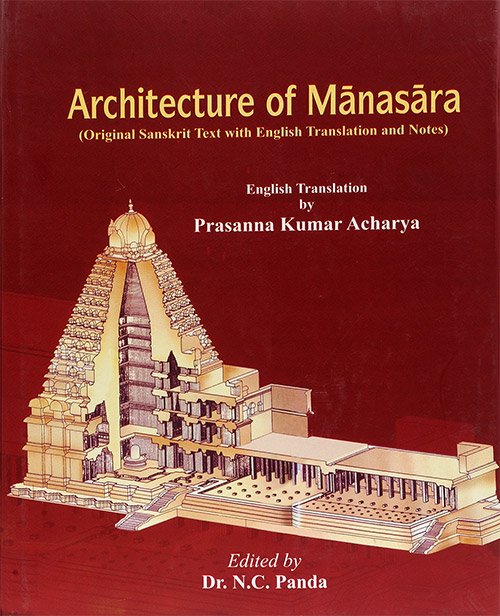Manasara (English translation)
by Prasanna Kumar Acharya | 1933 | 201,051 words
This page describes “the central theatre (madhyaranga)” which is Chapter 47 of the Manasara (English translation): an encyclopedic work dealing with the science of Indian architecture and sculptures. The Manasara was originaly written in Sanskrit (in roughly 10,000 verses) and dates to the 5th century A.D. or earlier.
Chapter 47 - The central theatre (madhyaraṅga)
1-2. The measurement and the characteristic features of the open shed (court) yard (muktaprapāṅga) fit for the residence and seats[1] of the gods and the kings will be described now.
3-4. That (courtyard) should be made within the central theatre [viz., madhyaraṅga], the breadth whereof should be divided into thirty-four parts; and the breadth of the ahed (prapā) proper is desired to be one part less on each side.
5-6. Of the four parts of the height of that (shed proper) the height of the plinth (or platform, maśūraka) should be one part; twice that (i.e., two parts) should be the height of the pillar (pāda), and one-half of that (i.e., one part) the height of the entablature.
7-11. As an alternative the (whole) height should be divided into eight parts in particular; of these the (height of the) platform (vedi) should be one part and a half, the height of the pillar five parts, and the height of the entablature one part and a half; or the height being divided into six parts, the height of the platform (vedi) should be one part, and the height of the pillar four parts, and the height of the entablature (mañca) one part: it should be adorned with all ornaments.
12. Four half-pillars (ardhāṅghri) may be, otherwise, erected with one-third (of the total height as their length).
13-15. The width of all pillars should be three, four, or five aṅgulas: thus is stated to be the (diameter of the) wooden pillars; (but) the stone pillars are specially recommended, of which the width should be six, seven, or eight aṅgulas.
16. They (the pillars) should be circular, square, octagonal, or sixteen-sided.
17-19. Of the eight parts of the height of the pillar the upper three parts should be ornamented with the capital (bodhikā), fist-band (muṣṭibandha), abacus (phalakā), tenia (tāṭikā), and pitcher (ghaṭa); it should be adorned with all ornaments; and the lotus-pedestal (padmāsana) should be attached at the bottom.
20. Thera should be made four porticos (bhadra) on the four sides, but according to some (authority) there may be only one portico.
21-22. There may be (at the bottom of the pillar) a base, or a pedestal, or the plinth (masūraka) together with a pedestal; or there should be only a signified platform (cihnavedi).
22-23. The ornaments of the shed (prapā) are described (below): it should be ornamented with crowning fillets (uttara), lower fillets (vājana), fist-bands (muṣṭi-bhandha [bandha?]), and pentroofs (lupā), etc.
24. There should be eight or sixteen small vestibules (kṣudranāsi) on all aides.
25. Its (shed’s) top portion should be decorated with the images of leographs (vyāla) and crocodiles (makara), etc.
26-549. Therewithin (i.e., inside the theatre) the thrones, etc., should be arranged (in tiers) in the middle of the yard (lit., hall, sabhā, for prapā), that is, comprising all kinds of seats assigned for ordinary, special, and occasional uses to the Cakravartin and the other classes of kings, as well as to the gods to be seated together with their consorts, as also for the accommodation of ordinary people (jana).
30-33. The thrones, the crocodile arches, the ornamental trees (kalpavṛkṣa) and the open shed (muktaprapāṅga) should be constructed of wood, stone, and brick, and other materials; it should be made (strong and) all the more beautiful with gems, with some special kind of metal (iron) profusely employed on many parts, and also by partitioning the walls (sāla).
84-37. If the measurement of the pillar, the base, and the upper mouldings (uttara) prescribed for the open shed (muktaprapāṅga) be less or greater, the king and the kingdom will be ruined.
Thus in the Mānasāra, the science of architecture, the forty-seventh chapter, entitled: “The description of the central theatre.”
Footnotes and references:
[1]:
Compare chapter XLVI, 30.
